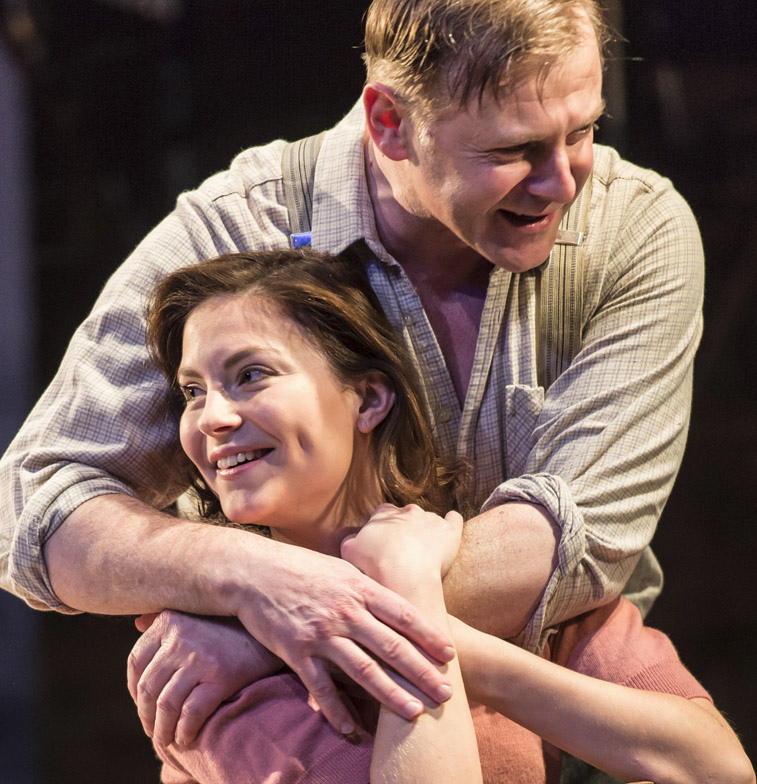Until the advent of the Kitchen Sink in Britain in 1957 and the arrival of Arnold Wesker, John Osborne et al most quality, “modern” drama was coming from the United States. While the West End was still dominated by gentle and genteel plays that involved a lot of smart people drinking cocktails while occasionally murdering each other in Mayfair apartments or large country houses, American playwrights like Tennessee Williams, Eugene O’Neill, Clifford Odets, Edward Albee and of course Arthur Miller, were getting down and dirty.
Although usually having a domestic setting, Arthur Miller’s plays are intrinsically American, many would say that they were a metaphor for disillusionment with the American dream. With the exception of The Crucible, which is a clear metaphor for the McCarthy witch-hunts, most of his work deals with home-based relationships and has a recurring theme. The plays start with a happy, contented family group with a respected, loved and beneficent patriarch who can do no wrong. Gradually, through the course of the play, cracks appear, events come to light, previously unsuspected character traits are revealed and poor old dad comes tumbling down – much as Uncle Sam had done in the eyes of writers and artists during the dark days McCarthyism.
A View from the Bridge, along with All My Sons, The Crucible and Death of a Salesman are Miller’s best and best-known plays. It deals with a poor but contented family of Italian immigrants living in the shadow of the Brooklyn Bridge in the 1950s. Eddie Carbone is a second generation longshoreman, taking work where he can find it, his wife Beatrice looks after the home and living with them is their teenage, orphaned niece, Catherine. One big happy family, although Eddie is perhaps a bit too happy to have Catherine under his roof. When two virile young illegal immigrant cousins arrive from Sicily in search of the American dream, the trouble starts. When the younger of them, the blond, and in the eyes of Eddie, effeminate, Rodolpho and Catherine become an item, you know that trouble is on the way.
All the performances were superlative and impossible to fault. Jonathan Guy Lewis was painful to watch as a man destroying himself and all those around him, craving the respect which he no longer deserves. Although, at the end of the play, the narrator, Alfieri, says he respects him more because he wasn’t afraid to show himself and all his faults.
Michael Brandon, as the lawyer Alfieri, tells the story and takes part in the action. He brings a calm authority and sanity to the proceedings but his entreaties are unable to remove Eddie’s finger from the self-destruct button. The ladies are excellent. Teresa Banham as the long suffering wife, never out of her pinnie, brought a quiet dignity to the home that was collapsing around her. Daisy Boulton was excellent and attractive as the exuberant, lovelorn Catherine, torn between family loyalties and the man she loves.
However, and I hate to say this, the brilliant performances and superlative play were badly let down by the set which was a total mess. The backcloth was all telegraph poles on wasteland which in no way reflected the urban, New York setting of the play – and not a bridge in sight, only a half-hearted representation of an apartment block with the obligatory fire escape. Furniture littered the stage, placed seemingly at random with no effort to delineate space or the different playing areas. The climactic fight scene at the end, which was supposed to take place in the street, bordered on farce with the protagonists chasing each other around a dining table laid for tea. The actors deserved much better and it was only the badly thought-out and disappointing visual presentation of the play that deprived them of the fifth star which they so clearly merited.
But don’t be put off; this is a must-see, tour-de-force play with some outstanding performances. ★★★★☆ Michael Hasted 11/03/15


